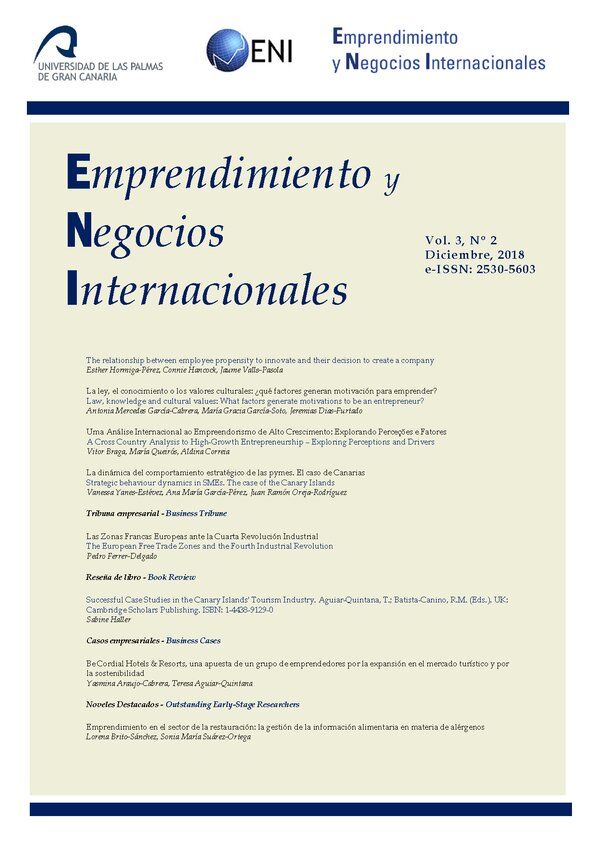The relationship between employee propensity to innovate and their decision to create a company
Resumen
The main objective of this paper is to analyze the relationship between the decisions by employees’ to initiate a new venture, whilst continuing in employment. Based on survey data collected from employees working for a public organization, we provide evidence that an analysis of individuals’ propensity to innovate, provides an insight into entrepreneurial intention which increases in probability where there is a lower opportunity cost. This study contributes to the growing empirical literature on entrepreneurial intentions which currently lacks focus on employed potential entrepreneurs.
Descargas
Citas
Amit, R., Muller, E., & Cockburn, I. (1995). Opportunity cost and entrepreneurial activity. Journal of Business Venturing, 10(2), 95-106.
Bobic, M., Davis, E., & Cunningham, R. (1999). The Kirton Adaptation-Innovation inventory. Review of Public Personnel Administration, 18, 18-31.
Cassar, G. (2006). Entrepreneur opportunity costs and intended venture growth. Journal of Business Venturing, 21(5), 610-632.
Corman, J., Perles, B., & Vancini, P. (1988). Motivational factors influencing high-technology entrepreneurship. Journal of Small Business Management, 26(January), 36-42.
Frank, H., Lueger, M., & Korunka, C. (2007). The significance of personality in business start-up intentions, start-up realization and business success. Entrepreneurship & Regional Development, 19(3), 227-251.
Hamilton, B. (1992). Does entrepreneurship pay? An empirical analysis of the returns to self-employment. PhD dissertation. Stanford University, Stanford, CA.
Katz, D. (1964). Motivational basis of organizational behavior. Behavioral Science, 9, 131-146.
King, N., & Anderson, N. (1995). Innovation and Change in Organizations. Routledge, London.
Liñán, F., & Chen, Y.W. (2009). Development and cross-cultural application of a specific instrument to measure entrepreneurial intentions. Entrepreneurship Theory and Practice, 33(3), 593-617.
Masclet, D., Colombier, N., Denant-Boemant, L., & Loheac, Y. (2009). Group and individual risk preferences: A lottery-choice experiment with self-employed and salaried workers. Journal of Economic Behavior and Organization, 70, 470-484.
Palich, L.E., & Bagby, D.R. (1995). Using cognitive theory to explain entrepreneurial risk-taking: challenging conventional wisdom. Journal of Business Venturing, 10(6), 425-438.
Ramamoorthy, N., Flood, P.C., Slattery, T., & Sardessai, R. (2005). Determinants of innovative work behaviour: development and test of an integrated model. Creativity and Innovation Management, 14(2), 142-150.
Scott, S.G., & Bruce, R.A. (1994). The influence of leadership, individual attributes and climate on innovative behaviour: a model of individual innovation in the workplace. The Academy of Management Journal, 37(3), 580-607.
Shaver, K.G., & Scott, L.R. (1991). Person, process, choice: the psychology of new venture creation. Entrepreneurship Theory and Practice, 16(2), 23-45.
Simon, M., Houghton, S.M., & Aquino, K. (2000). Cognitive biases, risk perception and venture formation: how individuals decide to start companies. Journal of Business Venturing, 15(2), 115-134.
Van de Ven, A.H. (1986). Central problems in the management of innovation. Management Science, 32(5), 590-607.
Van de Ven, A.H., Angle, H.L., & Poole, M.S. (1989). Research on the Management of Innovation: The Minnesota Studies, Harper & Row, New York, NY.
Van Praag, C.M., & Cramer, J.S. (2001). The Roots of Entrepreneurship and Labour Demand: Individual Ability and Low Risk Aversion. Economica, 68, 45-62.
West, M.A., & Farr, J.L. (1989). Innovation at Work: Psychological Perspectives. Social Behavior, 4, 15-30.
West, M.A., & Farr, J.L. (1990). Innovation and Creativity at Work, John Wiley, Chichester
Descargas
Publicado
Número
Sección
Licencia
Derechos de autor propuestos por Creative Commons
1. Política propuesta para revistas que ofrecen acceso abierto
Aquellos autores/as que tengan publicaciones con esta revista, aceptan los términos siguientes:
- Los autores/as conservarán sus derechos de autor y garantizarán a la revista el derecho de primera publicación de su obra, el cuál estará simultáneamente sujeto a la Licencia de reconocimiento de Creative Commons que permite a terceros compartir la obra siempre que se indique su autor y su primera publicación esta revista.
- Los autores/as podrán adoptar otros acuerdos de licencia no exclusiva de distribución de la versión de la obra publicada (p. ej.: depositarla en un archivo telemático institucional o publicarla en un volumen monográfico) siempre que se indique la publicación inicial en esta revista.
- Se permite y recomienda a los autores/as difundir su obra a través de Internet (p. ej.: en archivos telemáticos institucionales o en su página web) antes y durante el proceso de envío, lo cual puede producir intercambios interesantes y aumentar las citas de la obra publicada. (Véase El efecto del acceso abierto).

